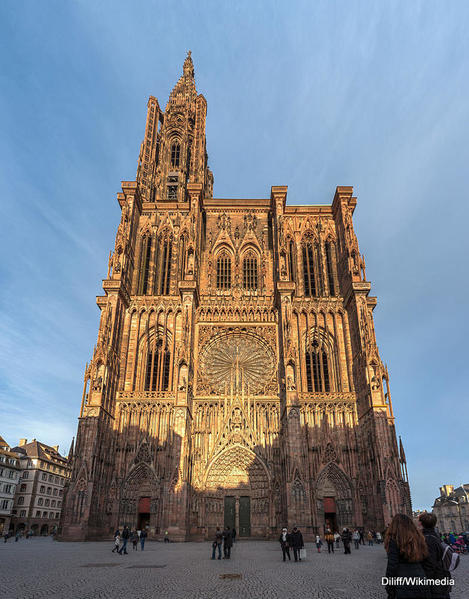There's a certain amount of truth to what some people say: If you've seen one cathedral, you've seen them all. But it's also true that the elements that are the same, once you recognize them, help you see the unique touches of each.
 And Strasbourg's cathedral is certainly unique, in almost more ways than can be counted. Some, like the small touches of informal sculpture seen above, are small. Others, like the startlingly-tall north tower, visible from far and wide, are large.
And Strasbourg's cathedral is certainly unique, in almost more ways than can be counted. Some, like the small touches of informal sculpture seen above, are small. Others, like the startlingly-tall north tower, visible from far and wide, are large.
In fact, it is so tall (nearly 470 feet) that for over two centuries, up to 1847,it was the tallest building in the world, and is still the tallest existing building built entirely in the Middle Ages. And it is easy to get carried away in details!
But the difference is in the details and some of he history that goes with them. An example: One of the best-known features of the cathedral are the thousands of figures, considered a master-piece of high Gothic. They, and the careful linearity of the tower are a reflection of a new development in building: architectural drawing. It's considered the first building whose structure would have been impossible without working from drawings.
As seems customary, it is neither the first religious use of the site nor the first cathedral there. A Roman sanctuary from the 1st century AD is under the pile, By the 4th century, Strasbourg's first cathedral occupied the spot, and was replaced in the 7th. In the 11th century, after a number of fires, a new cathedral was built, but burned down in 1176.
You might think a building dedicated to worship might be under God's protection, but apparently not. But the present cathedral, started in 1176, and re-using the crypt of the previous, has been more fortunate, surviving damage in all the wars that swept back and forth along the Rhine in the 16th and 17th centuries, and in later times as well.
Some of those wars were distinctly focused on religion, and therefore the Cathedral. When the area became Protestant in the 16th century, there were moves to destroy some of the statuary and decoration, but they did not go far. After the French Revolution, anti-clerical fervor and idealism led to threats to tear it down; instead, the tower was decorated with a Phrygian cap, the symbolic headwear of the Revolution, and nothing more happened.
There are Romanesque elements to be found here and there in the Cathedral; that's the style that was still in style when construction started. But 50 years later, architects and stonemasons coming from Chartres arrived and suggested going with Gothic. Much of the Romanesque work was actually torn down and rebuilt.
By the early 16th century, Strasbourg was a 'free imperial city' with a charter from the Holy Roman Emperor; the bishop was no longer the ruler of the city and its region. John Calvin, Martin Bucer and other Reformation figures gained influence in the city, and the City Council turned the cathedral over to the Protestants.
That change led not only to the struggle over the statuary, but also to another cathedral first: in 1539, the world's first documented public Christmas tree was set up inside the church.
The Protestant era at the Cathedral came in 1683, not with a change in religious sentiment, but with a change of management. Louis XIV, King of France, took control of the city, appointed French officials and a French bishop, and introduced French styles of architecture, including a huge new bishop's palace across from the cathedral. Known today as Palais Rohan, it houses several museums.
But the King's tolerance that allowed the local population to continue their Protestant worship had its limits when it came to the prize, the Cathedral. Alone of all the city's churches it was required to be turned over to the Catholic church, although a number of other churches in the city were split between two congregations.
Aside from the Cathedral's amazing mass of stained glass (carefully stored elsewhere during both World Wars), a popular feature is an astronomical clock with animated displays of courtiers, clerics and warriors chiming the noon hour. Unlike Prague's, which is in public view, a ticket is needed for Strasbourg's indoor clock, and the line is long.
I'll have to admit to a bit of amusement at these figures who seem to be hiding from each other around the base of a pillar, almost like a scene from a stage farce.
And outside, what every cathedral should have: A large memorial honoring the work of the stonemasons, architects, carpenters and others who turned the concept into the huge monument we see.


Comments (0)